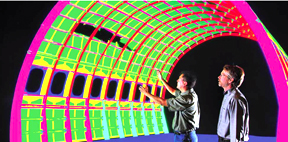
When the Advanced Simulation and Computing (ASC) program was established by the DOE in 1995, the end result was a shift in emphasis from test-based confidence in the nation’s nuclear arsenal to simulation-based confidence.
But the ASC program — which is now an NNSA program — and the computer modeling capability at its core are now providing a new, no less vital service: developing a scientific basis for aviation security explosive detection requirements. The findings are expected to lead to revisions to the Transportation Security Administration’s certification standards.
“Today, under ASC, computer simulation capabilities are routinely developed to analyze and predict the performance, safety, and reliability of nuclear weapons and to certify their functionality,” says Sandia’s Jim Phelan (6418), who leads the tri-lab effort. “We’re now able to leverage that capability and apply it to the important problem of damage from explosives aboard aircraft.”
The current requirements for screening checked baggage for explosives at airports were established in 1993 following the Pan Am Flight 103 bombing in 1988. The requirements, however, were based on forensic assessments of historic incidents and actual explosive tests with retired aircraft. Such assessments, says Jim, offer incomplete and limited knowledge of factors that must be considered when trying to mitigate the threat of onboard explosions.
“Today, we have a much better understanding of the range of explosives threats, such as liquid explosives and homemade bombs,” says Jim. “But what we have not had is a more detailed understanding of the differing explosive power from potential threat materials and the impact on the aircraft structure. That’s where computational modeling comes in.”
Leveraging the high-performance computing capability DOE has developed over the past decade, Sandia and its partners — Lawrence Livermore National Laboratory and Los Alamos National Laboratory — now have access to lightning-fast supercomputers, parallel computing software, and visualization features currently used to support the nation’s nuclear weapons complex.
“ASC tools are very applicable to solving the aviation onboard explosion problem,” says Jim. Computational modeling, he says, offers a scientific basis for the breadth of explosive threats that cannot be derived by the empirical tests historically conducted.
“Those kinds of tests have to be done, because they are the ground truth for actual aircraft explosions,” Jim says. But such tests alone, he adds, can’t adequately examine the multitude of factors that must be considered, including explosives and aircraft types, threat quantity, onboard locations, flight conditions, and other physical details that factor into managing the risks from aviation terrorism.
“You absolutely must do modeling to assess where the threshold is before performing a test,” he says.
The tri-lab team’s first order of business when taking on this challenge last year was to “scope” the problem and determine how ASC tools could best go about tackling it. In December, a briefing that included several sample simulation results was delivered to TSA, which then asked the team to reproduce a series of historic experimental tests and determine whether modeling could, indeed, produce valid results. Another briefing, in June, confirmed the modeling capability.
Computational modeling, says Jim, offers several advantages above and beyond the obvious avoidance of aircraft destruction for experimental purposes. Hydrodynamic blast models, which are supported by decades of explosive science measurement and analysis, accurately determine the high pressures caused by detonations. Finite element structural models, which represent the structural components of an aircraft’s airframe, can show the tearing, bending, and breaking of the airframe components.
The tri-lab team is working with a major aircraft manufacturer to use detailed structural information on one of the aircraft in today’s fleet, information that is subsequently used in the computational models. By this fall, the team will provide TSA with a report on the vulnerability to a common fleet aircraft, and revisions to the certification standards are expected to commence shortly thereafter.
Jim emphasizes that the project has been a team effort, with contributions from Dennis Roach (6416) and the Aircraft Airworthiness project; Ken Smith (6418) from Contraband Detection Dept; Jeff Gruda (1524), Kenneth Gwinn (1524), Jonathan Rath (1524), Tim Shelton (1524) and Marlin Kipp (1431) from the Advanced Simulation and Computing program; and Jerry Stofleth (5434) and the Explosives Applications Department.